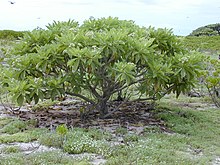Heliotropium foertherianum
Heliotropium foertherianum | |
|---|---|
 | |
| In the Hawaiian Islands | |
Conservation status | |
 Least Concern (IUCN 2.3)[1] | |
Scientific classification | |
| Kingdom: | Plantae |
Clade: | Angiosperms |
Clade: | Eudicots |
Clade: | Asterids |
| Order: | Boraginales |
| Family: | Boraginaceae |
| Genus: | Heliotropium |
| Species: | H. foertherianum |
Binomial name | |
Heliotropium foertherianum Diane & Hilger | |
Synonyms | |
Tournefortia argentea L.f. | |
Heliotropium foertherianum is a species of flowering plant in the borage family, Boraginaceae. It is native to tropical Asia including southern China, Madagascar, northern Australia, and most of the atolls and high islands of Micronesia and Polynesia. Common names include velvetleaf soldierbush,[2]tree heliotrope, veloutier, and octopus bush. It is a shrub or small tree typical of littoral zones reaching a height of 3.6 m (12 ft), with a spread of about 5 m (16 ft).[citation needed]
Contents
1 Taxonomy
2 Uses
2.1 Wood
2.2 Medicinal
3 References
4 External links
Taxonomy
Originally published as Tournefortia argentea, it was transferred to Argusia argentea, and remained under that name until recently. It was subsequently restored to Tournefortia before being transferred into Heliotropium under a new name in 2003.[3][4]
Uses


Flower
Historically in the Maldives the leaves were often used as famine food.[5]
Wood
The wood of H. foertherianum is commonly used to make handicrafts, tools, and, in Polynesia, frames for swim goggles. Due to its availability, H. foertherianum is used as firewood, and has become rare in some areas as a result.[6]
Medicinal
Octopus bush is used in many Pacific islands as a traditional medicine to treat ciguatera fish poisoning, which is caused by powerful ciguatoxins produced by microscopic Gambierdiscus algae. Scientists from the Institute of Research for Development (IRD) and the Louis Malarde Institute in French Polynesia and Pasteur Institute in New Caledonia are researching the plant chemistry and believe that senescent leaves contain rosmarinic acid and derivatives, which are known for its antiviral, antibacterial, antioxidant, and anti-inflammatory properties.[7] The researchers think rosmarinic acid may remove the ciguatoxins from their sites of action, as well as being an anti-inflammatory.
References
^ World Conservation Monitoring Centre 1998. Argusia argentea. 2006 IUCN Red List of Threatened Species. Archived 2014-06-27 at the Wayback Machine Downloaded on 20 August 2007.
^ "Tournefortia argentea". Natural Resources Conservation Service PLANTS Database. USDA. Retrieved 11 December 2015..mw-parser-output cite.citationfont-style:inherit.mw-parser-output .citation qquotes:"""""""'""'".mw-parser-output .citation .cs1-lock-free abackground:url("//upload.wikimedia.org/wikipedia/commons/thumb/6/65/Lock-green.svg/9px-Lock-green.svg.png")no-repeat;background-position:right .1em center.mw-parser-output .citation .cs1-lock-limited a,.mw-parser-output .citation .cs1-lock-registration abackground:url("//upload.wikimedia.org/wikipedia/commons/thumb/d/d6/Lock-gray-alt-2.svg/9px-Lock-gray-alt-2.svg.png")no-repeat;background-position:right .1em center.mw-parser-output .citation .cs1-lock-subscription abackground:url("//upload.wikimedia.org/wikipedia/commons/thumb/a/aa/Lock-red-alt-2.svg/9px-Lock-red-alt-2.svg.png")no-repeat;background-position:right .1em center.mw-parser-output .cs1-subscription,.mw-parser-output .cs1-registrationcolor:#555.mw-parser-output .cs1-subscription span,.mw-parser-output .cs1-registration spanborder-bottom:1px dotted;cursor:help.mw-parser-output .cs1-ws-icon abackground:url("//upload.wikimedia.org/wikipedia/commons/thumb/4/4c/Wikisource-logo.svg/12px-Wikisource-logo.svg.png")no-repeat;background-position:right .1em center.mw-parser-output code.cs1-codecolor:inherit;background:inherit;border:inherit;padding:inherit.mw-parser-output .cs1-hidden-errordisplay:none;font-size:100%.mw-parser-output .cs1-visible-errorfont-size:100%.mw-parser-output .cs1-maintdisplay:none;color:#33aa33;margin-left:0.3em.mw-parser-output .cs1-subscription,.mw-parser-output .cs1-registration,.mw-parser-output .cs1-formatfont-size:95%.mw-parser-output .cs1-kern-left,.mw-parser-output .cs1-kern-wl-leftpadding-left:0.2em.mw-parser-output .cs1-kern-right,.mw-parser-output .cs1-kern-wl-rightpadding-right:0.2em
^ "IngentaConnect A systematic analysis of Heliotropiaceae (Boraginales) based on t". Botanische Jahrbücher. 125: 19–51. 2003-12-01. doi:10.1127/0006-8152/2003/0125-0019.
^ "Heliotropium foertherianum Diane & Hilger". Australian Plant Name Index (APNI), IBIS database. Centre for Plant Biodiversity Research, Australian Government.
^ Eating on the Islands - As times have changed, so has the Maldives' unique cuisine and culture
^ Elevitch, Craig R.; Harley I. Manner (April 2006). "Tournefortia argentea (tree heliotrope)" (PDF). The Traditional Tree Initiative.
^ Rossi F, Jullian V, Pawlowiez R, Kumar-Roiné S, Haddad M, Darius HT, Gaertner-Mazouni N, Chinain M, and Laurent D (30 August 2012). "Protective effect of Heliotropium foertherianum (Boraginaceae) folk remedy and its active compound, rosmarinic acid, against a Pacific ciguatoxin". Journal of Ethnopharmacology. 143 (1): 33–40. doi:10.1016/j.jep.2012.05.045.
External links
 Data related to Tournefortia argentea at Wikispecies
Data related to Tournefortia argentea at Wikispecies- Plants of Midway Atoll
This Asterid article is a stub. You can help Wikipedia by expanding it. |
This tree-related article is a stub. You can help Wikipedia by expanding it. |
This Australian asterid article is a stub. You can help Wikipedia by expanding it. |
